选自3dbabove
参与:乾树、刘晓坤
本文使用通俗的语言和形象的图示,介绍了随机梯度下降算法和它的三种经典变体,并提供了完整的实现代码。
GitHub 链接:https://github.com/ManuelGonzalezRivero/3dbabove
代价函数的多种优化方法
目标函数是衡量预测值和实际值的相似程度的指标。通常,我们希望得到使代价尽可能小的参数集,而这意味着你的算法性能不错。函数的最小可能代价被称为最小值。有时一个代价函数可以有多个局部极小值。幸运的是,在参数空间的维数非常高的情况下,阻碍目标函数充分优化的局部最小值并不经常出现,因为这意味着对象函数相对于每个参数在训练过程的早期都是凹的。但这并非常态,通常我们得到的是许多鞍点,而不是真正的最小值。
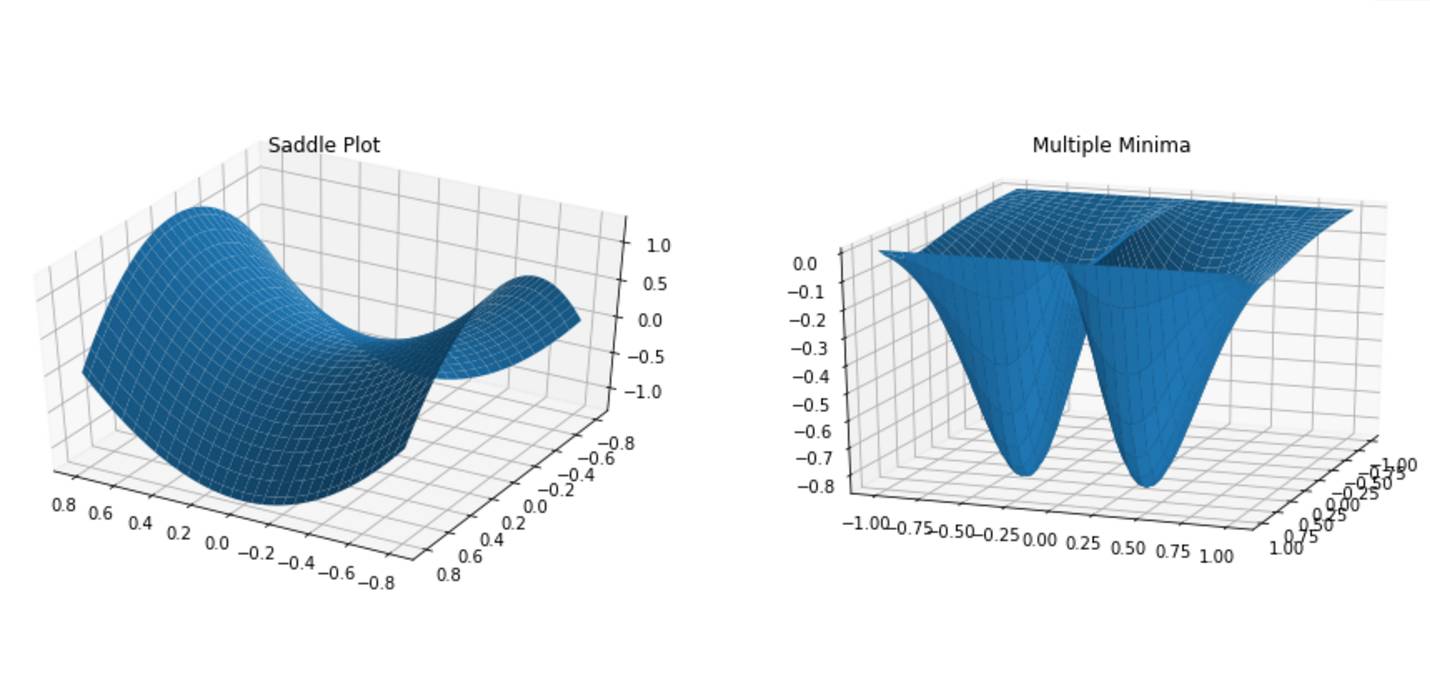
找到生成最小值的一组参数的算法被称为优化算法。我们发现随着算法复杂度的增加,则算法倾向于更高效地逼近最小值。我们将在这篇文章中讨论以下算法:
随机梯度下降法
动量算法
RMSProp
Adam 算法
随机梯度下降法
我的「Logistic 回归深入浅出」的文章里介绍了一个随机梯度下降如何运作的例子。如果你查阅随机梯度下降法的资料(SGD),通常会遇到如下的等式:

资料上会说,θ是你试图找到最小化 J 的参数,这里的 J 称为目标函数。最后,我们将学习率记为α。通常要反复应用上述等式,直到达到你所需的代价值。
这是什么意思?想一想,假如你坐在一座山顶上的雪橇上,望着另一座山丘。如果你滑下山丘,你会自然地往下移动,直到你最终停在山脚。如果第一座小山足够陡峭,你可能会开始滑上另一座山的一侧。从这个比喻中你可以想到:
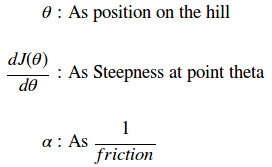
学习率越高意味着摩擦力越小,因此雪橇会像在冰上一样沿着山坡下滑。低的学习率意味着摩擦力高,所以雪橇会像在地毯上一样,难以滑下。我们如何用上面的方程来模拟这种效果?
随机梯度下降法:
初始化参数(θ,学习率)
计算每个θ处的梯度
更新参数
重复步骤 2 和 3,直到代价值稳定
让我们用一个简单的例子来看看它是如何运作的!
在这里我们看到一个目标函数和它的导数(梯度):
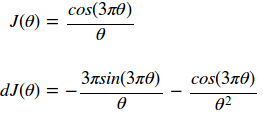
我们可以用下面的代码生成函数和梯度值/30 的图:
importnumpy asnp
defminimaFunction(theta):
returnnp.cos(3*np.pi*theta)/theta
defminimaFunctionDerivative(theta):
const1 =3*np.pi
const2 =const1*theta
return-(const1*np.sin(const2)/theta)-np.cos(const2)/theta**2
theta =np.arange(.1,2.1,.01)
Jtheta=minimaFunction(theta)
dJtheta =minimaFunctionDerivative(theta)
plt.plot(theta,Jtheta,label =r'$J(theta)$')
plt.plot(theta,dJtheta/30,label =r'$dJ(theta)/30$')
plt.legend()
axes =plt.gca()
#axes.set_ylim([-10,10])
plt.ylabel(r'$J(theta),dJ(theta)/30$')
plt.xlabel(r'$theta$')
plt.title(r'$J(theta),dJ(theta)/30 $ vs $theta$')
plt.show()

上图中有两个细节值得注意。首先,注意这个代价函数有几个极小值(大约在 0.25、1.0 和 1.7 附近取得)。其次,注意在最小值处的导数在零附近的曲线走向。这个点就是我们所需要的新参。
我们可以在下面的代码中看到上面四个步骤的实现。它还会生成一个视频,显示每个步骤的θ和梯度的值。
importnumpy asnp
importmatplotlib.pyplot asplt
importmatplotlib.animation asanimation
defoptimize(iterations,oF,dOF,params,learningRate):
"""
computes the optimal value of params for a given objective function and its derivative
Arguments:
- iteratoins - the number of iterations required to optimize the objective function
- oF - the objective function
- dOF - the derivative function of the objective function
- params - the parameters of the function to optimize
- learningRate - the learning rate
Return:
- oParams - the list of optimized parameters at each step of iteration
"""
oParams =[params]
#The iteration loop
fori inrange(iterations):
# Compute the derivative of the parameters
dParams =dOF(params)
# Compute the update
params =params-learningRate*dParams
# app end the new parameters
oParams.append(params)
returnnp.array(oParams)
defminimaFunction(theta):
returnnp.cos(3*np.pi*theta)/theta
defminimaFunctionDerivative(theta):
const1 =3*np.pi
const2 =const1*theta
return-(const1*np.sin(const2)/theta)-np.cos(const2)/theta**2
theta =.6
iterations=45
learningRate =.0007
optimizedParameters =optimize(iterations,
minimaFunction,
minimaFunctionDerivative,
theta,
learningRate)
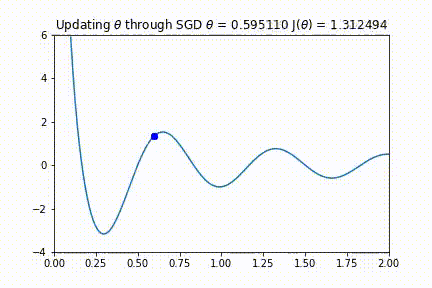
这似乎运作得很好!您应该注意到,如果θ的初始值较大,则优化算法将在某一个局部极小处结束。然而,如上所述,在极高维度空间中这种可能性并不大,因为它要求所有参数同时满足凹函数。
你可能会想,「如果我们的学习率太大,会发生什么?」。如果步长过大,则算法可能永远不会找到如下的动画所示的最佳值。监控代价函数并确保它单调递减,这一点很重要。如果没有单调递减,可能需要降低学习率。
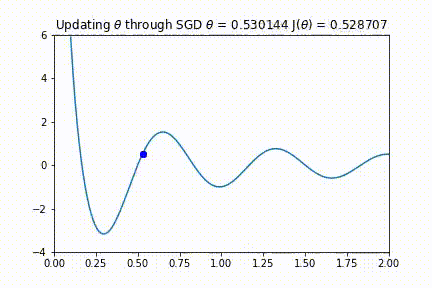
SGD 也适用于多变量参数空间的情况。我们可以将二维函数绘制成等高线图。在这里你可以看到 SGD 对一个不对称的碗形函数同样有效。
importnumpy asnp
importmatplotlib.mlab asmlab
importmatplotlib.pyplot asplt
importscipy.stats
importmatplotlib.animation asanimation
defminimaFunction(params):
#Bivariate Normal function
X,Y =params
sigma11,sigma12,mu11,mu12 =(3.0,.5,0.0,0.0)
Z1 =mlab.bivariate_normal(X,Y,sigma11,sigma12,mu11,mu12)
Z =Z1
return-40*Z
defminimaFunctionDerivative(params):
# Derivative of the bivariate normal function
X,Y =params
sigma11,sigma12,mu11,mu12 =(3.0,.5,0.0,0.0)
dZ1X =-scipy.stats.norm.pdf(X,mu11,sigma11)*(mu11 -X)/sigma11**2
dZ1Y =-scipy.stats.norm.pdf(Y,mu12,sigma12)*(mu12 -Y)/sigma12**2
return(dZ1X,dZ1Y)
defoptimize(iterations,oF,dOF,params,learningRate,beta):
"""
computes the optimal value of params for a given objective function and its derivative
Arguments:
- iteratoins - the number of iterations required to optimize the objective function
- oF - the objective function
- dOF - the derivative function of the objective function
- params - the parameters of the function to optimize
- learningRate - the learning rate
- beta - The weighted moving average parameter
Return:
- oParams - the list of optimized parameters at each step of iteration
"""
oParams =[params]
vdw =(0.0,0.0)
#The iteration loop
fori inrange(iterations):
# Compute the derivative of the parameters
dParams =dOF(params)
#SGD in this line Goes through each parameter and applies parameter = parameter -learningrate*dParameter
params =tuple([par-learningRate*dPar fordPar,par inzip(dParams,params)])
# append the new parameters
oParams.append(params)
returnoParams
iterations=100
learningRate =1
beta =.9
x,y =4.0,1.0
params =(x,y)
optimizedParameters =optimize(iterations,
minimaFunction,
minimaFunctionDerivative,
params,
learningRate,
beta)
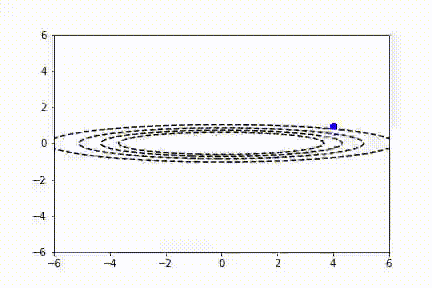
动量 SGD
注意,传统 SGD 没有解决所有问题!通常,用户想要使用非常大的学习速率来快速学习感兴趣的参数。不幸的是,当代价函数波动较大时,这可能导致不稳定。你可以看到,在前面的视频中,由于缺乏水平方向上的最小值,y 参数方向的抖动形式。动量算法试图使用过去的梯度预测学习率来解决这个问题。通常,使用动量的 SGD 通过以下公式更新参数:

γ 和 ν 值允许用户对 dJ(θ) 的前一个值和当前值进行加权来确定新的θ值。人们通常选择γ和ν的值来创建指数加权移动平均值,如下所示:

β参数的最佳选择是 0.9。选择一个等于 1-1/t 的β值可以让用户更愿意考虑νdw 的最新 t 值。这种简单的改变可以使优化过程产生显著的结果!我们现在可以使用更大的学习率,并在尽可能短的时间内收敛!
importnumpy asnp
importmatplotlib.mlab asmlab
importmatplotlib.pyplot asplt
importscipy.stats
importmatplotlib.animation asanimation
defminimaFunction(params):
#Bivariate Normal function
X,Y =params
sigma11,sigma12,mu11,mu12 =(3.0,.5,0.0,0.0)
Z1 =mlab.bivariate_normal(X,Y,sigma11,sigma12,mu11,mu12)
Z =Z1
return-40*Z
defminimaFunctionDerivative(params):
# Derivative of the bivariate normal function
X,Y =params
sigma11,sigma12,mu11,mu12 =(3.0,.5,0.0,0.0)
dZ1X =-scipy.stats.norm.pdf(X,mu11,sigma11)*(mu11 -X)/sigma11**2
dZ1Y =-scipy.stats.norm.pdf(Y,mu12,sigma12)*(mu12 -Y)/sigma12**2
return(dZ1X,dZ1Y)
defoptimize(iterations,oF,dOF,params,learningRate,beta):
"""
computes the optimal value of params for a given objective function and its derivative
Arguments:
- iteratoins - the number of iterations required to optimize the objective function
- oF - the objective function
- dOF - the derivative function of the objective function
- params - the parameters of the function to optimize
- learningRate - the learning rate
- beta - The weighted moving average parameter for momentum
Return:
- oParams - the list of optimized parameters at each step of iteration
"""
oParams =[params]
vdw =(0.0,0.0)
#The iteration loop
fori inrange(iterations):
# Compute the derivative of the parameters
dParams =dOF(params)
# Compute the momentum of each gradient vdw = vdw*beta+(1.0+beta)*dPar
vdw =tuple([vDW*beta+(1.0-beta)*dPar fordPar,vDW inzip(dParams,vdw)])
#SGD in this line Goes through each parameter and applies parameter = parameter -learningrate*dParameter
params =tuple([par-learningRate*dPar fordPar,par inzip(vdw,params)])
# append the new parameters
oParams.append(params)
returnoParams
iterations=100
learningRate =5.3
beta =.9
x,y =4.0,1.0
params =(x,y)
optimizedParameters =optimize(iterations,
minimaFunction,
minimaFunctionDerivative,
params,
learningRate,
beta)
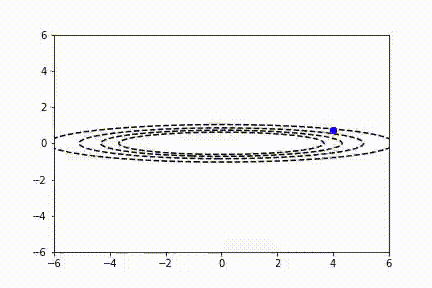
RMSProp
像工程中的其它事物一样,我们一直在努力做得更好。RMS prop 试图通过观察关于每个参数的函数梯度的相对大小,来改善动量函数。因此,我们可以取每个梯度平方的加权指数移动平均值,并按比例归一化梯度下降函数。具有较大梯度的参数的 sdw 值将变得比具有较小梯度的参数大得多,从而使代价函数平滑下降到最小值。可以在下面的等式中看到:
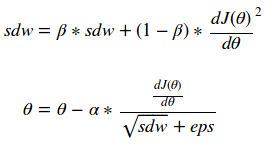
请注意,这里的 epsilon 是为数值稳定性而添加的,可以取 10e-7。这是为什么昵?
importnumpy asnp
importmatplotlib.mlab asmlab
importmatplotlib.pyplot asplt
importscipy.stats
importmatplotlib.animation asanimation
defminimaFunction(params):
#Bivariate Normal function
X,Y =params
sigma11,sigma12,mu11,mu12 =(3.0,.5,0.0,0.0)
Z1 =mlab.bivariate_normal(X,Y,sigma11,sigma12,mu11,mu12)
Z =Z1
return-40*Z
defminimaFunctionDerivative(params):
# Derivative of the bivariate normal function
X,Y =params
sigma11,sigma12,mu11,mu12 =(3.0,.5,0.0,0.0)
dZ1X =-scipy.stats.norm.pdf(X,mu11,sigma11)*(mu11 -X)/sigma11**2
dZ1Y =-scipy.stats.norm.pdf(Y,mu12,sigma12)*(mu12 -Y)/sigma12**2
return(dZ1X,dZ1Y)
defoptimize(iterations,oF,dOF,params,learningRate,beta):
"""
computes the optimal value of params for a given objective function and its derivative
Arguments:
- iteratoins - the number of iterations required to optimize the objective function
- oF - the objective function
- dOF - the derivative function of the objective function
- params - the parameters of the function to optimize
- learningRate - the learning rate
- beta - The weighted moving average parameter for RMSProp
Return:
- oParams - the list of optimized parameters at each step of iteration
"""
oParams =[params]
sdw =(0.0,0.0)
eps =10**(-7)
#The iteration loop
fori inrange(iterations):
# Compute the derivative of the parameters
dParams =dOF(params)
# Compute the momentum of each gradient sdw = sdw*beta+(1.0+beta)*dPar^2
sdw =tuple([sDW*beta+(1.0-beta)*dPar**2fordPar,sDW inzip(dParams,sdw)])
#SGD in this line Goes through each parameter and applies parameter = parameter -learningrate*dParameter
params =tuple([par-learningRate*dPar/((sDW**.5)+eps)forsDW,par,dPar inzip(sdw,params,dParams)])
# append the new parameters
oParams.append(params)
returnoParams
iterations=10
learningRate =.3
beta =.9
x,y =5.0,1.0
params =(x,y)
optimizedParameters =optimize(iterations,
minimaFunction,
minimaFunctionDerivative,
params,
learningRate,
beta)

Adam 算法
Adam 算法将动量和 RMSProp 的概念结合成一种算法,以获得两全其美的效果。公式如下:

importnumpy asnp
importmatplotlib.mlab asmlab
importmatplotlib.pyplot asplt
importscipy.stats
importmatplotlib.animation asanimation
defminimaFunction(params):
#Bivariate Normal function
X,Y =params
sigma11,sigma12,mu11,mu12 =(3.0,.5,0.0,0.0)
Z1 =mlab.bivariate_normal(X,Y,sigma11,sigma12,mu11,mu12)
Z =Z1
return-40*Z
defminimaFunctionDerivative(params):
# Derivative of the bivariate normal function
X,Y =params
sigma11,sigma12,mu11,mu12 =(3.0,.5,0.0,0.0)
dZ1X =-scipy.stats.norm.pdf(X,mu11,sigma11)*(mu11 -X)/sigma11**2
dZ1Y =-scipy.stats.norm.pdf(Y,mu12,sigma12)*(mu12 -Y)/sigma12**2
return(dZ1X,dZ1Y)
defoptimize(iterations,oF,dOF,params,learningRate,beta1,beta2):
"""
computes the optimal value of params for a given objective function and its derivative
Arguments:
- iteratoins - the number of iterations required to optimize the objective function
- oF - the objective function
- dOF - the derivative function of the objective function
- params - the parameters of the function to optimize
- learningRate - the learning rate
- beta1 - The weighted moving average parameter for momentum component of ADAM
- beta2 - The weighted moving average parameter for RMSProp component of ADAM
Return:
- oParams - the list of optimized parameters at each step of iteration
"""
oParams =[params]
vdw =(0.0,0.0)
sdw =(0.0,0.0)
vdwCorr =(0.0,0.0)
sdwCorr =(0.0,0.0)
eps =10**(-7)
#The iteration loop
fori inrange(iterations):
# Compute the derivative of the parameters
dParams =dOF(params)
# Compute the momentum of each gradient vdw = vdw*beta+(1.0+beta)*dPar
vdw =tuple([vDW*beta1+(1.0-beta1)*dPar fordPar,vDW inzip(dParams,vdw)])
# Compute the rms of each gradient sdw = sdw*beta+(1.0+beta)*dPar^2
sdw =tuple([sDW*beta2+(1.0-beta2)*dPar**2.0fordPar,sDW inzip(dParams,sdw)])
# Compute the weight boosting for sdw and vdw
vdwCorr =tuple([vDW/(1.0-beta1**(i+1.0))forvDW invdw])
sdwCorr =tuple([sDW/(1.0-beta2**(i+1.0))forsDW insdw])
#SGD in this line Goes through each parameter and applies parameter = parameter -learningrate*dParameter
params =tuple([par-learningRate*vdwCORR/((sdwCORR**.5)+eps)forsdwCORR,vdwCORR,par inzip(vdwCorr,sdwCorr,params)])
# append the new parameters
oParams.append(params)
returnoParams
iterations=100
learningRate =.1
beta1 =.9
beta2 =.999
x,y =5.0,1.0
params =(x,y)
optimizedParameters =optimize(iterations,
minimaFunction,
minimaFunctionDerivative,
params,
learningRate,
beta1,
beta2)</div>
Adam 算法可能是目前深度学习中使用最广泛的优化算法,适用于多种应用。Adam 计算了一个 νdw^corr 的值,用于加快指数加权移动平均值的变化。它将通过增加它们的值来对它们进行标准化,与当前的迭代次数成反比。使用 Adam 时有一些很好的初始值可供尝试。它最好以 0.9 的 β_1 和 0.999 的 β_2 开头。
总结
优化目标函数的算法有相当多的选择。在上述示例中,我们发现各种方法的收敛速度越来越快:
– SGD: 100 次迭代
– SGD+Momentum: 50 次迭代
– RMSProp: 10 次迭代
– ADAM: 5 次迭代
原文链接:https://3dbabove.com/2017/11/14/optimizationalgorithms/
本文为机器之心编译,转载请联系本公众号获得授权。返回搜狐,查看更多
责任编辑:

